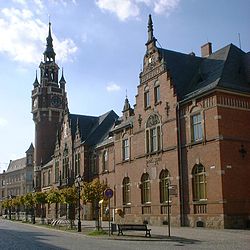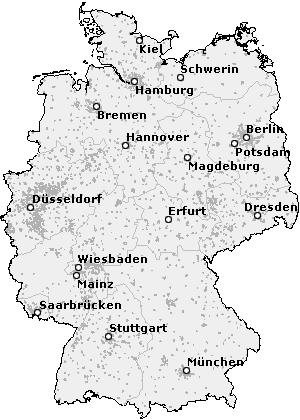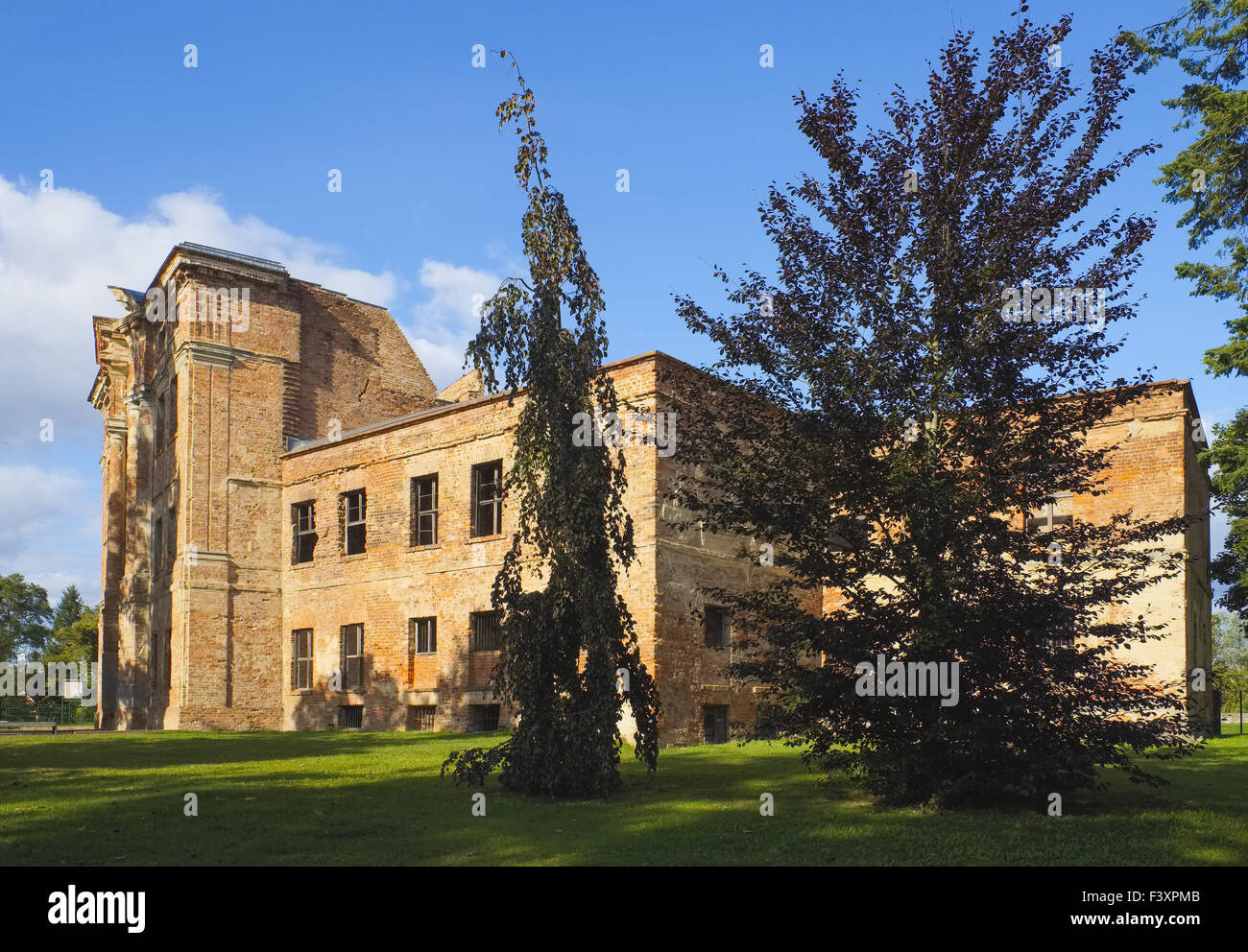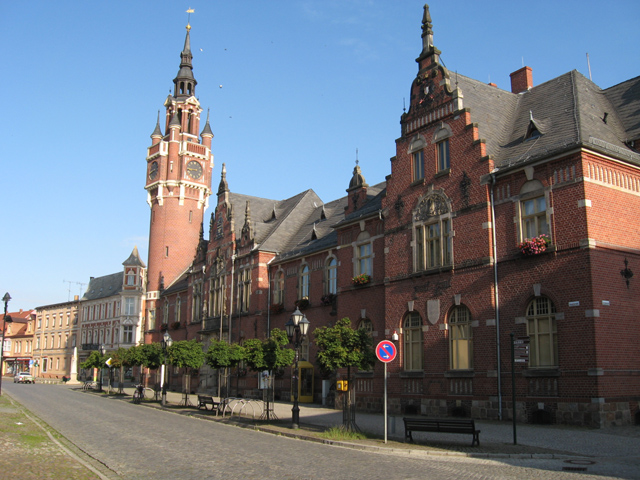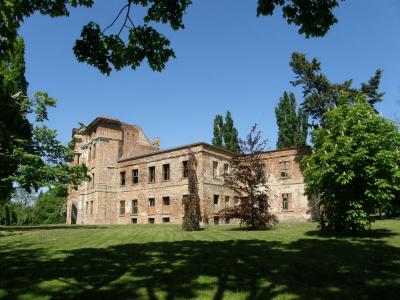Dahme, Brandenburg
Dahme / Mark is an official belonging to town in the Teltow -Flaming in southern Brandenburg.
- 2.1 Amalgamations
- 2.2 Demographics
- 3.1 City Council
- 3.2 Coat of Arms
- 3.3 flag
- 4.1 Structures
- 4.2 parks
- 4.3 Natural Monuments
- 4.4 Historical Monuments
- 4.5 Sports
- 5.1 Sons and daughters of the town
- 5.2 Other personalities who are associated with the city
Geography
Through the town of the same river Dahme, which rises near and in Berlin- Köpenick flows into the River Spree flows. In Dahmer Land of Low and the Flaming Niederlausitzer border wall meet. Relatively large fields and numerous meadows dominate the landscape.
Boroughs
The town of Dahme / Mark divided into districts
- Buckow
- Dahme / Mark
- Gebersdorf
- Kemlitz ( Lower Sorbian: Kamjenica ) with the inhabited part of municipality Altsorgefeld
- Niebendorf - Heinsdorf
- Schoena - Kolpien
- Rosenthal
- Sieve
- Floating village
- Wahlendorf with the inhabited part of municipality Liepe
- Zagelsdorf
History
Dahme was first mentioned in 1186 as the centerpiece of the castle district and purchased at this time of Archbishop Wichmann of Magdeburg, realizing his reign Jiiterbog advanced. Approximately 1150-1300 immigrated to the region south of Berlin Fleming and founded villages and towns. Even today, old Flemish customs are maintained in Dahme. 1265 Dahme was mentioned in a charter as a city. The Peace of Prague in 1635 Dahme came to the Electorate of Saxony and 1815 due to the Congress of Vienna to Prussia, where it was assigned to the province of Brandenburg. Since then, went in order to distinguish the suffix " Mark " necessary because there was already a Dahme in the Kingdom of Prussia.
Incorporations
Floating village was incorporated in 1957. Zagelsdorf was added in 1974. The end of 2001 Dahme / Mark has been increased by four municipalities in 2003 for a further three communities.
Demographics
Forecasts of population change
The population of the present Dahme / Mark stagnated since the end of the 19th century. The refugees from the former eastern territories of Germany gave the city the mid 20th century a population boost. The population forecasts assume that Dahme / Mark 2000-2030 loses about 15 % of its inhabitants.
Policy
City Council
The city council of Dahme / Mark consists of 18 councilors.
- SPD: 6 seats ( 1)
- FWG: 4 seats (-1)
- LEFT: 3 seats (± 0)
- WG Dahme: 3 seats (± 0)
- CDU: 2 seats (± 0)
(As at municipal election held on September 28, 2008 )
Coat of arms
The coat of arms was approved on 3 July 1992, but goes back to common in the 17th century seal.
Blazon: " Argent, a crenellated red brick wall with three bezinnten round towers, open black gate and pulled up a silver portcullis; at the higher and stronger central tower, at the left a black ladder leaning, a growing, natural, blue-clad female figure with green palm branch in his raised right hand. The coat of arms is a reference to the city of Magdeburg, as the city at that time belonged to the Archbishopric of Magdeburg. Also there is the female figure in the coat of arms talking. The earliest still surviving coat of arms " CIVITATIS LADIES" of 1399 and other 15th and 16th century show a three-towered castle with ladder, but without female figure. The onion-shaped roof of the central tower was later replaced by the female figure. "
Flag
The flag of the city is red - white striped.
Culture and sights
In the list of monuments in Dahme / Mark and in the list of ground monuments in Dahme / Mark are registered in the list of monuments of the country Brandenburg cultural monuments.
Structures
The historic old town is surrounded by a lawn, built of iron stones and boulders city wall, which is called the Iron Wall; it was already mentioned in 1265 and has been preserved to 80%. In July 2004, the city walls of the working group " cities with historic centers ", is in the Dahme member, as a " monument of the month" was.
Granary
Comprehensive school "Otto Unspoiled " in Dahme, Brandenburg
City wall
City wall
Town hall
Electorate of Saxony Postmeilensäule
The foundations of the church of St. Mary dating from the mid -13th century. The place and thus the church burned more than once, the last time on 27 June 1666. Starting in 1670, the church was rebuilt in the Baroque style. The altar in the interior dates from the year 1678, the organ of A. Schuke ( II/19 ) from the year 1989. A preserving the architecture of the entire roof structure began in late 2012. The work will take the time to.
The village church Niebendorf is a native of the late Romanesque period, heavily modified in the 17th century stone building with extensive Baroque interior. Under the Innenputz 2009/2010 of the monuments also baroque decorative paintings were uncovered. The interior of the church is being restored in stages since 2009.
The Town Hall was built in 1893/1894 to a design by the architect Max Jacob in the Neo-Renaissance style in brick construction. Previously located at the old market, the Electorate of Saxony postal distance column.
The bird tower, which formerly belonged to one of the two city gates, was in 1563 when a city fire heavily damaged and rebuilt in 1892.
Erected in 1724 Granary is the largest timber-framed buildings ( used until 1989) in Dahme. In a 1735 built half-timbered building on the northwest corner of the Potter's Market, the local museum and the municipal library are housed.
The Dahme castle was the involvement of the buildings of a medieval castle of the Lords of Dahme under the dukes of Saxe- Weissenfels Friedrich ( * 1673, † 1715 ) and Johann Adolf II (* 1685, † 1746 ) from 1711 to 1714 into a baroque palace with representative Mittelrisalit redesigned. At the building of the Silesian architect Elias Scholtz and the Saxon architect Johann Christoph contactors were involved. After aborted reorganization measures, the castle fell into ruin after 1957, which has been secured from 1994 to 2008 with the participation of the German Foundation for Monument Protection and since then used for cultural purposes.
Parks
In the castle grounds there is a small zoo since 1901.
Natural Monuments
In the neighboring nature parks of Lower Landrücken and Dahme- Heideseen cyclists and walkers come on well-maintained trails at their expense; Water sports enthusiasts find many lakes available.
Historical monuments
Memorial for the Victims of National Socialism at the Otto- Zaacke Square.
Sports
The city lies on the flaming- skate and has an outdoor pool, a multipurpose hall, a tennis court and a football field. The TSV Empor Dahme also has two handball teams, a men's team and an e- youth team
Personalities
Sons and daughters of the town
- Unspoiled Otto (1806-1873), discoverer of aniline
- Friedrich Wilhelm Kullrich (* 1821 in Dahme, † 1887 in Berlin), came from a family of blacksmiths Dahmer and was a major medal in Berlin. He was married to a niece of August Borsig. In Dahmer Heritage Museum is a collection of his medals. Kullrich was the medalist of the Goldmark, was introduced with the unification in 1871.
- Marie Kahle (1893-1948), wrote in 1945 in London about their experiences in Nazi Germany, the book " What would you have done? "
- Georg Buchholz (around 1503-1566 ), Lutheran theologian and reformer
- Abraham Buchholz (1529-1584), historian
- Johann Gottfried Leschnert (1681-1747) educator and historian
- Max Jacob (1849-1921), architect
- Karsten Greve (* 1946), art dealers
- Roswitha Krause ( born 1949 ), Women's Swimming and Women's Handball
- Birgit Vanderbeke (* 1956), writer
- Marco Thinius (* 1968), bassoonist and chess player
Other personalities who are associated with the city
- Hermann Hellriegel (1831-1895), was the first director of the Agricultural Experiment Station in Dahme 1857-1873.
- Richard Ulbricht (1834-1907), conducted from 1886 to 1904, the agricultural experimental station in Dahme.
- Otto Lemmermann (1869-1953), conducted from 1904 to 1905, the agricultural experimental station in Dahme
- Frieda Amerlan (1841-1924), youth writer who lived from 1895 until her death as a pin lady in Dahme
- Otto wave (* March 2, 1888; † November 2, 1943 ), SPD - local leader and member of the Prussian County Council, died as a result of his imprisonment in a concentration camp Oranienburg. To him since 1969 a memorial plaque at the cemetery outside wall in the potions road.
- Max Hannemann, cigar maker and SPD city councilor, in 1944 imprisoned in Sachsenhausen concentration camp, probably perished during the death march in April 1945. At him a plaque in the Max Hannemann 50th Street
- Günther Marks (1897-1978), German church musician, cantor, educator, organist and composer; Professor of organ and church music at the Lutheran catechetical seminar in Dahme
- Volker Ochs ( * 1929), German composer and church music director of the Evangelical Church in Berlin- Brandenburg. He lives in Dahme / Mark and is an honorary citizen of the city. He founded the singing weeks in Berlin / Brandenburg initiated the seminar for church service in Dahme / Mark.

